what is the name given to the values that are used in a functions calculations?
This tutorial is introducing the new Excel Let function that makes intricate formulas expect more comprehensible and calculate faster.
If you piece of work with lengthy formulas in Excel, then you are certainly familiar with the idea of named ranges that make complex formulas easier to read. And now, Microsoft is making a pace farther and allows assigning names to calculations and values directly in a formula. If your formula uses the same expression several times, you tin let Excel summate information technology simply one time, store the issue inside a formula and reuse as many times every bit needed. Sounds exciting, isn't it?
Excel LET function
The Excel Allow function allows you to assign names to adding results and ascertain variables inside a formula, and then that the formula looks clearer and works faster.
Essentially, the concept is the same as naming cells, ranges and formulas in the Proper noun Manager. What makes the LET function different is that the declared names simply exist in the scope of a given formula and nowhere else.
Syntax
Allow has the post-obit syntax and arguments:
LET (name1, name_value1, [name2], [name_value2], …, adding)
Where:
- Name1 (required) - the first name to assign. It must brainstorm with a letter.
- Name_value1 (required) - the value or calculation assigned to name1.
- Name2 / name_value2 (optional) - the 2d name and value.
- Adding (required) - a calculation that uses assigned names and values.
The role can process up to 126 proper noun/value pairs.
Note. Microsoft uses a slightly dissimilar syntax note:
Permit(name1, name_value1, calculation_or_name2, [name_value2, calculation_or_name3…])
I personally find it a little confusing, and so I put it in a more customary grade. Basically, they talk about the same matter simply in different means.
Availability
The LET role is but available in Microsoft 365 subscriptions, including:
- Excel 365 (for Windows and Mac)
- Excel 2021 (for Windows and Mac)
- Excel for the web
Bones LET formula
If you practice not accept a clear understanding of the function nonetheless, an case of the Let formula in its simplest grade will help bring the essentials into focus.
Consider this simple expression: 10+y. Here, we accept 2 variables, x and y. Allow's assign the value 2 to x, the value 5 to y and multiply one by the other:
=LET(x, ii, y, five, x*y)
Enter this formula in a cell, and information technology will render x as the result.
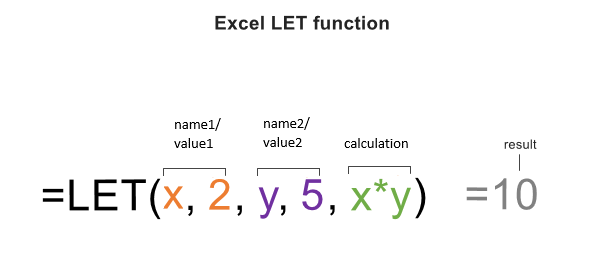
Instead of values, the variables tin be assigned to cell references, say x to B2 and y to B3:
=Permit(x,B2, y, B3, x * y)

To ease building a formula, the already declared names appear in the intellisense driblet down list, just like the names defined in the proper name manager.
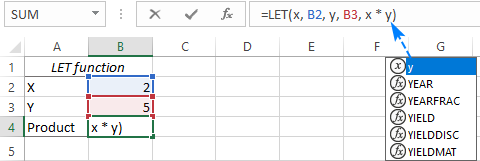
Looking at the above formula you may be wondering, what's the point in over-complicating things? Why not just put:
=B2*B3
In this particular case, a normal multiplication is of course simpler. The purpose is to clarify the concept. When information technology comes to more than complex formulas with repeated calculations, the Allow function takes on a whole new degree of usefulness as demonstrated in the further examples.
Advantages
If you still doubt that LET volition be a worthy addition to your Excel toolbox, then consider these benefits:
Simplified formulas. Giving descriptive names to variables and intermediate calculations makes it easier to understand what the formula is actually doing. You no longer need to effigy out the inner logic of each specific expression or reference in a formula.
Faster calculations. When the same expression is repeated in a formula multiple times, Excel calculates it multiple times. When the expression is referred by proper noun, Excel calculates it only once. As the result, a whole worksheet recalculates much faster. This positive issue on operation is particularly noticeable in instance of long formulas and huge data sets.
Easy maintenance. Using names for repeated calculations not only makes formulas more compact but besides easier to update. When adjustments are needed, you make but a single change instead of updating the same expressions multiple times, thus saving time and reducing a alter of human errors.
Usage notes
To shorten the learning curve and prevent common errors, delight follow these simple guidelines:
- A LET formula should have an odd number of arguments - ane or several proper name/value pairs and a calculation. The last argument must always be a calculation that returns the concluding event.
- In your formulas, adhere to the same naming rules equally in the name manager, i.e. outset with a letter, no spaces, no punctuation characters, etc.
- To avoid confusion, avoid declaring names that are already used in the proper name director. If the aforementioned name is assigned inside Let and defined in the name manager, the proper noun manager version volition be ignored.
- The names declared with LET are merely valid in the scope of that detail formula.
How to use Permit function in Excel - formula examples
And now, it's time to expect at more realistic use cases and reveal the whole power of the new function.
Instance i. LET formula to reduce repeated calculations
When writing multi-level formulas, it often happens that the same expression or calculation is used more than than once. A typical example is nested IF statements. In this context, permit's run across how Permit can simplify things.
Supposing you have the results of student exams in 3 different subjects (columns B, C and D). You want to observe an average for each student and form it every bit shown in the tabular array on the right:
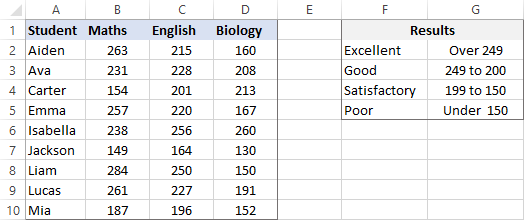
The Average function can easily compute an arithmetic mean for each row:
AVERAGE(B2:D2)
And and then, you build a nested IF statement based on the in a higher place criteria.
=IF(AVERAGE(B2:D2)>249, "First-class", IF(Average(B2:D2)>=200, "Skillful", IF(Boilerplate(B2:D2)>150, "Satisfactory", "Poor")))
The problem is the same Average role is repeated three times. Well, maybe non actually a problem, merely an unnecessary complication that forces Excel to perform the same calculation thrice.
To optimize the formula, we tin can assign a proper name to the Boilerplate role (say, avg) and replace the function with this "local" proper noun. This style, an average is calculated merely in one case helping the formula run faster:
=Permit(avg, AVERAGE(B2:D2), IF(avg>249, "Excellent", IF(avg>=200, "Skillful", IF(avg>150, "Satisfactory", "Poor"))))
Enter the formula in E2, drag it downwardly through E10, and you lot'll get this result:
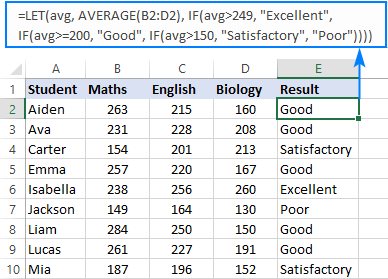
Imagine yous add ane more test (cavalcade Due east) to the source table. Naturally, y'all wish to include that in the average. Without LET, you'd have to perform this adjustment in the logical test of every IF function. Being a homo, you might overlook something and fail to update all the references correctly. With LET, y'all make just a single change:
=Let(avg, Average(B2:E2), IF(avg>249, "Fantabulous", IF(avg>=200, "Good", IF(avg>150, "Satisfactory", "Poor"))))
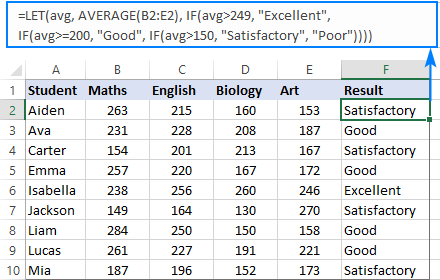
Example 2. LET with multiple names
Here's some other example showing how the Permit function tin can ease the cosmos of complex formulas.
Let'due south say you lot have a listing of full names (column A) from which you wish to excerpt middle names. The below formula does the job perfectly, but at outset sight its logic is quite obscure:
=MID(A2, SEARCH(" ", A2) + 1, SEARCH(" ", A2, SEARCH(" ", A2) +1) - SEARCH(" ", A2) - 1)
To provide some meaningful context to yourself and other users, yous tin can define a couple of names such as:
- full_name - A2
- space - SEARCH(" ", full_name)
Obviously, cell A2 contains a full name that needs to be split, and the SEARCH part returns the position of the first infinite character in the name.
Then, we supercede the cell reference and the SEARCH function with the alleged names.
=Permit(full_name, A2, space, SEARCH(" ", full_name), MID(full_name, space + 1, SEARCH(" ", full_name, infinite + 1) - space - one))
If you are familiar with the MID syntax, the formula becomes much easier to encompass:
To the position of the kickoff space, you add 1 to start the extraction from the adjacent grapheme (space+1). To become the length of the middle proper noun (i.e. how many characters to extract from the full name), y'all make up one's mind the position of the second space by nesting 1 SEARCH function into another, and so notice the departure between the positions of the ii spaces and decrease 1 from the result to eliminate a trailing space (SEARCH(" ", full_name, space+1) - space -1)).
For ameliorate readability, you tin warp the names and calculation onto separate lines like this:
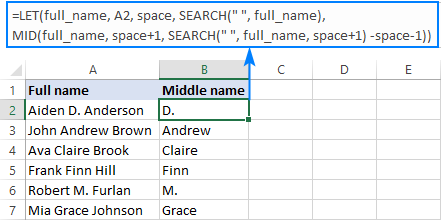
Example iii. Permit role with dynamic arrays
In the previous examples, the LET function operated on a single prison cell, and nosotros copied the formula to the below cells. Nonetheless, Permit tin also take arrays equally input and produce arrays as output. This is possible due to Excel 365'south new adding engine and dynamic arrays.
From the beneath table, suppose yous want to get a listing of exams that are to exist taken in the next n days, not including today. This can be washed by using the FILTER office with multiple criteria:
FILTER(data, (dates>today) * (dates<=today+northward), "No results")
All y'all need to practice is to define the corresponding names:
- data - A2:C19
- dates - C2:C19
- today - TODAY()
- due north - F3
Later that, put the names and FILTER formula inside LET:
=Permit(data, A2:C19, dates, C2:C19, today, TODAY(), north, F3, FILTER(data, (dates>today) * (dates<=today+north), "No results"))
The upshot is an array of records matching the specified criteria:
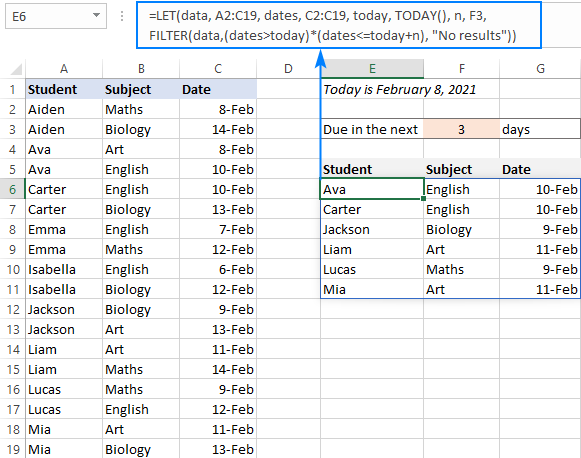
Excel LET function not working
If y'all cannot find the LET office in your Excel or your formula results in fault, that may happen because of the post-obit reasons:
In that location is no LET function in my Excel
At the time of writing, the Let function is only bachelor to Office Insiders. When the beta phase is completed, it will exist released to all Microsoft 365 subscribers. The function is not backward uniform and won't announced in before Excel versions.
#Name? fault
As there's a very slim chance that someone may misprint the function'due south proper name, the problem is most likely with assigned names. Please brand certain you've declared each name used in the calculation and all of the names are spelled correctly.
That's how you lot can simplify and speed up your calculations with the help of the LET function. I cheers for reading and promise to see you on our blog next week!
Practise workbook for download
Excel LET formula examples (.xlsx file)
You may besides be interested in:
Source: https://www.ablebits.com/office-addins-blog/let-function-formula-examples/
Post a Comment for "what is the name given to the values that are used in a functions calculations?"